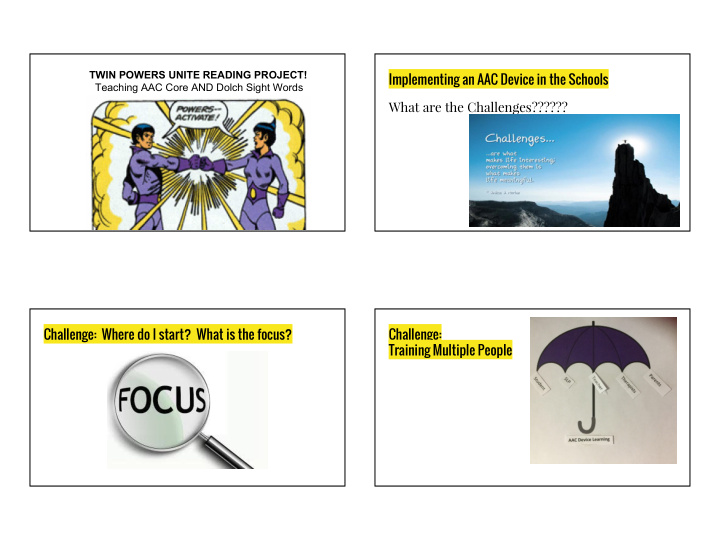



TWIN POWERS UNITE READING PROJECT! Implementing an AAC Device in the Schools Teaching AAC Core AND Dolch Sight Words What are the Challenges?????? Challenge: Where do I start? What is the focus? Challenge: Training Multiple People
Challenge: Generalizing ! From Therapy to Real Life! Challenge: Including AAC in Literacy Access to books our students can independently In School ! At home! With peers! read or share in the reading is a challenge! CORE Language - Small set of commonly used words that support communication and language learning - 85% of what we say is communicated with only 200 basic core words - Consistent across place, topic, and cognitive ability - For a child to become an effective communicator, either verbally or with the assistance of a device, he/she must master these basic core words
DLM First Forty - Dynamic Learning Maps (DLM) and the Alternative Assessment Consortium based on work by Karen Erickson at the University of North Carolina. - These words are recommended for students who use augmentative and alternative communication (AAC) - These words were selected from a larger core vocabulary set based on their usefulness in everyday communication and in addressing the DLM™ Essential Elements. Dolch Sight Words - Dolch Word List, was compiled by Edward William Dolch, PhD, in 1948 - - The list was originally published in his book "Problems in Reading" - - 220 "service words" that must be quickly recognized in order to achieve reading fluency. - - The Dolch Word List is also called Sight Words or The Dolch 220. - - It includes the most frequently used words in the English language. - - Sight words make up 50 to 70 percent of any general text
Which is more Important??? Valuable Real Estate Matter of perspective…… If you could only speak 40 words, would you want one of them to be “the”? Communication - CORE Reading - Dolch/Sight Words Twin Powers Unite - Working Together! Partner Augmented Input (Modeling) Twenty Words We Have in Common - Cross Referenced - A powerful, evidence based approach in which communication partners point to the symbols on the child’s communication device while (20 on DLM First 40 list AND 20 on Dolch Pre-Primer or Primer Lists) simultaneously talking - As each book is introduced, an adult will “read” book with the AAC device Chosen Based on Scholastic Sight Word Readers following a guide created by Chat Editor Although 20 Words are Targets, due to other high frequency words in texts, - Peers will also use this guide to learn and read using their friend’s talker! many more will be covered (ie. the, a, at, play, get) - How we teach an “umbrella full of people” the device! This is where you start!!! Video on Using Modeling
Power of Peer Modeling Data Collection - Strategy researched by Kathy Bourque from the University of Kansas -Baseline Data will be collected on both peers week of Jan. 11 - Children responded better to peer modeling than they did to adults! - Three data points to collect: - Reading partners or book buddies as peers - High expectations for peer to be in role as “teacher” 1. Receptive knowledge of targeted words in field of 3 - Goal is to improve sight word recognition of both students 2. Receptive knowledge of targeted words in phrase or sentence - Using book as common denominator, helps us generalize 3. Expressive (verbal or on device) recitation of targeted words Data sheets provided in packet. (Receptive, Context and Expressive) Reading from Field of Three Reading in Contextual Sentence Sentence Video Reading from a Field of Three Video Link
Expressive - Reading with Voice or Device Specifics of Project - Ten students targeted in grades K-1 who use either NovaChat or TouchChat Expressive Video Link to communicate (20,42 or 60 layout) - Why? Fewer than 10% of AAC users read beyond the second grade level (Erickson, 2003) - Each student will be paired with a peer who also needs to learn his/her sight words - Project Information Summary Sheet Project Schedule Reading Paths and Guides Two books/week with 2-3 targeted words - 5 min/day - schedule in packet Reading paths for each book will be provided on a separate sheet to promote independence Each child receives copy of each book Reading guide supplied to block out Adult reads selection to both students using provided guide on Monday extraneous information Two times/week adult reads again with AAC user - may be shared reading where student fills in target word At end of project, paths with guides Two time/week both peers read selections together can be sent home for parents to use Weekly intervention data sheet Might be used in ESY as well! Helps us model and generalize!
What it Looks Like in Action! In the Classroom! Partner Modeling In the Classroom Commenting Post Intervention Data Collection Data will be collected at end of 9 weeks Students can then take all books home with reading guides At the end of each week, both students For returning students, it will be fun to test again in the fall! will be asked to complete a comment sheet for each book. Why? Commenting provides each student with a unique voice and way to state their opinion! This is often a forgotten communicative function for our AAC users!
Our Results Book Bag Each child will be provided with a book bag to store books, flashcards and comment sheets. At end of project, books may be sent home and parents encouraged to read with their child! Again, modeling and generalization! Extension Ideas Brown Bear
Recommend
More recommend